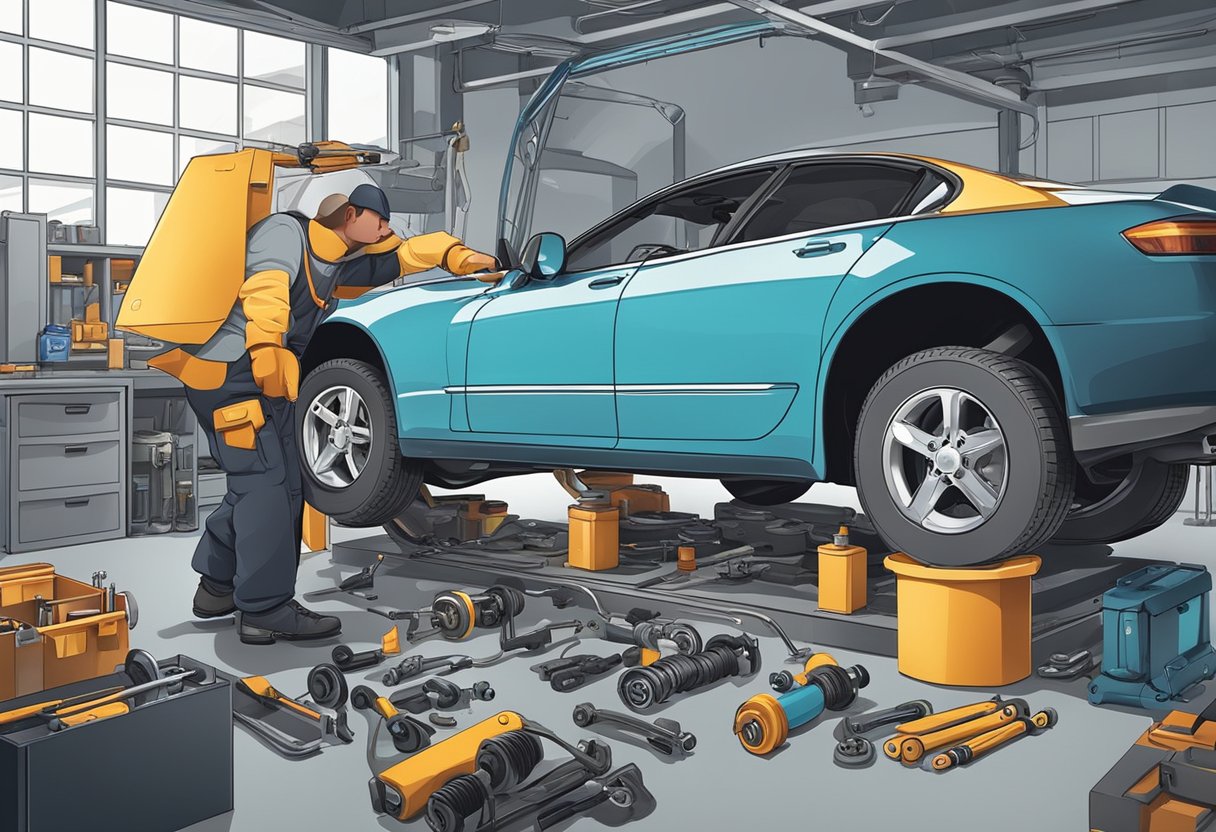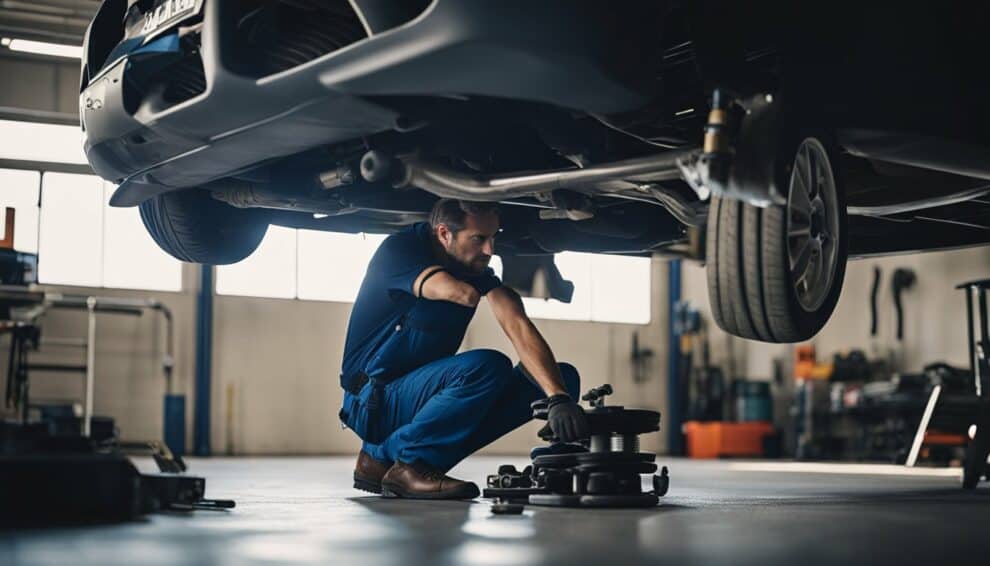The cost of replacing a car’s rear suspension can vary greatly depending on several factors, including the type of vehicle, the extent of the damage, and where one opts to have the repairs done.
Typical expenses for this type of repair fall somewhere between a wide range of $200 to over $1,500.
A basic understanding of the components involved, like shock absorbers and suspension arms, can help car owners anticipate and breakdown these costs.

Car owners may find that the price of parts significantly influences the overall expense. While off-the-market components might offer a cost-effective solution, original equipment manufacturer (OEM) parts typically come with the promise of better quality and fit for the vehicle.
Labor costs can also add up quickly; in some cases, labor might even outpace the cost of parts themselves. For instance, replacing the rear suspension arm may incur different labor charges depending on the car model and the shop’s rates.
The cost of replacing rear suspension parts on a car can vary significantly depending on several factors, such as the type of vehicle, the quality of parts used, and the labor costs. Here’s a general idea of what you might expect to pay for different suspension repairs:
- Shock Absorbers/Struts Replacement: Depending on the car type and part costs, replacing all four shocks and struts might range from $500 to $1,500.
- Spring Replacement: Replacing coil springs can cost between $225 to $500 per spring. It’s common to replace springs in pairs.
- Ball Joint Replacement: For one ball joint, the cost might be between $150 to $300, and for all four, it could range from $600 to $1,200.
- Control Arm Replacement: This could cost around $500 to $750 on average.
- Complete Suspension Overhaul: In cases where a full replacement is needed, such as after an accident or for an upgrade, the cost could exceed $3,500, especially if using performance parts.
To give more specific examples, for a 2011 Subaru Forester, the cost to replace a rear lower arm might be around $196 for an aftermarket part and $353 for a factory upper arm. For a 2005 Chevrolet Silverado 4WD, replacing a lower control arm could cost about $338 using aftermarket parts or $518 with factory parts.
What are the Signs that My Car’s Rear Suspension Needs to be Replaced?
If you notice your car’s rear end dipping lower than usual, experiencing a bumpy or noisy ride, or feeling the car swaying or leaning to one side, these are all signs of bad spark plugs that your car’s rear suspension may need to be replaced. It’s important to have a professional mechanic inspect and address any issues promptly.
Understanding Rear Suspension Systems

When it comes to a vehicle’s rear suspension, it should be understood that this complex assembly directly influences ride quality and handling. The components involved work together to provide stability and absorb bumps from the road.
Suspension Components and Function
The rear suspension system typically consists of shock absorbers, springs (such as coil springs), struts (on some vehicles), control arms, bushings, ball joints, and the sway bar. Here’s a quick rundown:
- Shock Absorbers: They dampen vibrations and jolts from uneven road surfaces.
- Springs: These components support the vehicle’s weight and absorb larger shocks, contributing to a smooth ride.
- Struts: Struts are a structural part of the suspension system and combine a shock absorber and spring in one unit.
- Control Arms: They allow wheels to move up and down while preventing forward and backward motion.
- Bushings: These provide a cushioning effect between other suspension components, reducing friction and wear.
- Ball Joints: Acting like the hip joint in the human body, they allow the control arms to move up and down and swivel.
- Sway Bar: It minimizes body roll during cornering and helps maintain the car’s stability.
The entire suspension assembly works in unison to keep the tires in contact with the road and assist the steering knuckle in turning the wheels.
Common Rear Suspension Issues and Symptoms
Over time, the parts of a rear suspension system can wear out or fail. Here are some common problems and the symptoms they might present:
- Worn Shock Absorbers: A car might experience excessive vibrations or take longer to settle after hitting a bump.
- Springs Issues: If a coil spring breaks, it can cause the vehicle to sag on one side.
- Faulty Struts: A knocking sound when going over bumps or difficulty steering could indicate strut problems.
- Bad Control Arms or Bushings: Clunking noises during turning or acceleration may occur.
- Failing Ball Joints: Irregular tire wear and wandering steering are symptoms.
- Worn Sway Bars: Excessive body roll in corners can be noticeable.
Routine checks and maintenance, like ensuring proper alignment, can significantly prolong the life of these components and maintain the vehicle’s connection between the chassis and the road.
Rear Suspension Replacement Costs

Cost Factors for Suspension Repair
The total cost of rear suspension replacement can vary widely depending on the make and model of the vehicle, as well as the type of suspension system it employs.
For instance, a Subaru Forester’s Macpherson strut design might have different repair costs compared to a vehicle using a different system.
Aftermarket parts typically offer a more cost-effective solution, but OEM parts ensure a certain level of quality and compatibility.
The condition of suspension components like the shock absorbers, control arms, and tires will also affect the price, as additional repairs may be needed if they exhibit signs of wear such as rust, cupping, or uneven tire wear.
Labor Costs and Time Estimates
Labor costs can significantly impact the repair cost, with rates varying by location and the service provider’s rate. For a typical job such as replacing rear shocks, labor might take a few hours, while more involved repairs like replacing a full suspension system will take longer and cost more.
Luxury cars or those with sophisticated suspension systems, like a Jeep Grand Cherokee, often incur higher labor charges due to the complexity of the work.
OEM vs Aftermarket Replacement Parts
Original equipment manufacturer (OEM parts) are often more expensive than aftermarket parts. However, they assure the vehicle owner of receiving components specifically designed for their model.
Conversely, aftermarket parts can provide a similar level of performance and durability at a reduced price but may not have the same guarantee of fit and finish as OEM parts. The choice between the two often comes down to budget and personal preference.
Potential Additional Repairs
The replacement of rear suspension might uncover or cause the need for other repairs. Services such as a wheel alignment may be necessary following suspension work to ensure proper steering and stability.
Other wear items like tires might need to be replaced if damaged or worn, and if the suspension suffered from severe rust or damage, additional components may need repair or replacement.
It’s also important to check if the car’s insurance covers any portion of the car suspension repair costs, particularly in the event of an accident-related failure.
As an Amazon Associate we earn from qualifying purchases.











I’ve noticed my car has started making a clunking noise whenever I turn or accelerate sharply. Could this be related to the control arms or bushings, and if so, how urgent is it to get this repaired?